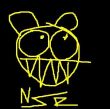| btimm |
|
16 Dec 2009 09:19 | Quote |
Joined: 14 Dec 2009 United States  Lessons: 2 Licks: 1 Karma: 16 
|
I was reading about minor chord structures and how they are derived from the major chords. It seemed that the 3rd note in the chord is made flat and that is how it works. I was trying to quiz myself with various chords and I noticed right away that this was not the case with C. The C chord is x32010. I guessed that Cm would then be x31010, since we would take the E note in the chord and change it to Eb. I was aprtially right. I looked and it showed that it was actually x31013. So the 3rd note (E) was dropped a half-step, but then the next octave up, the E was raised to a G. Why is this? |
| Schecter_player |
|
16 Dec 2009 09:30 | Quote |
Joined: 12 Jul 2009 Canada  Karma Karma: 3 
|
In a C minor chord you can't have any Es. In that voicing of C major, there are two Es. The only thing you did wrong is that you forgot to flatten one of the Es. Now, since that E is an open string, you can't flatten it. So the easiest way to make it a proper chord C minor chord is to change the E into the closest other note in the chord. It happens to be a G.
hope that helps |
| Guitarslinger124 |
|
16 Dec 2009 10:14 | Quote |
Joined: 25 Jul 2007 United States  Lessons: 12 Licks: 42 Karma: 38  Moderator Moderator
|
The reason you add the G is because it is the fifth of C. To build a major chord you use the root, third and fifth. To build a minor chord you use the root, flat third and fifth. |
| JustJeff |
|
16 Dec 2009 11:45 | Quote |
Joined: way back United States  Lessons: 2 Karma: 21 
|
When you are doing chord theory, take it away from the guitar first.
Your C chord is a C, E, and G. When you make a minor chord, you need C, Eb, G. When you look at your chord shape of x32010, it goes xCEGCE. We need to flatten BOTH E's in the chord shape. Since we can't really do this open, we can either
A) play as x31013
B) play as x3101x
C) play as x35543
D) play as (insert variation here)
Happy learning! |
| btimm |
|
17 Dec 2009 07:08 | Quote |
Joined: 14 Dec 2009 United States  Lessons: 2 Licks: 1 Karma: 16 
|
Thanks guys. What confused me was the E note on the bottom string. I knew that flatting it wasn't an option, since it is played open, but I did not that you could just change the note to the closest note in the chord, that is pretty cool. It's pretty overwhelming reading these forums and seeing how much I have to learn, but also really cool. |
| gx1327 |
|
17 Dec 2009 08:20 | Quote |
Joined: 20 Sep 2009 United States  Karma Karma: 9 
|
you could also mute the high E string. as long as you start on the root note (C) and play one Eb and one G, you are playing the Cm chord. the common open chords are basically the easiest way to play certain chords, but you can make up your own. the common open chords (CAGED) contain anywhere from 4-6 individual notes, they are octaves of the 3 notes in the chord. the root note is usually one of the repeated notes...
barre chords will have 5 or 6 individual notes in them, too.
but judging from your profile picture you are still young, so you have plenty of time to learn this. it is very overwhelming at first, but once yous tart pecking away at it it becomes a lot easier to grasp (even if you don't understand it all, you can piece together what you know and what you don't know). the guitar is a very neat instrument. i used to play saxophone which was very linear, but the guitar is very clever in the way the strings are layed out. |
| Schecter_player |
|
17 Dec 2009 09:57 | Quote |
Joined: 12 Jul 2009 Canada  Karma Karma: 3 
|
gx1327 says: but judging from your profile picture you are still young
hahahaha |
| btimm |
|
17 Dec 2009 11:31 | Quote |
Joined: 14 Dec 2009 United States  Lessons: 2 Licks: 1 Karma: 16 
|
gx1327 says: but judging from your profile picture you are still young
What can I say? I am a prodigy. lol |
|
|






